50-Minute Classroom: How to Buy Knives
01 October 2010By Adam Weiner
 Part 1 of a two-part series from Chef Weiner on advising your students on selecting and maintaining knives.
Part 1 of a two-part series from Chef Weiner on advising your students on selecting and maintaining knives.
All culinary students will ask you, at one time or another, about buying knives. Since we are all busy, I thought I would make your life a bit simpler. Just print out the below and give it to your students.
A. How to Purchase Knives
The most important thing to remember when buying a knife is: Does it feel good in your hand? If it doesn’t, you will never want to use it no matter how expensive the knife. Price is not the key factor. Like most other things in life, the more something costs the better it may be, but with knives, feel is far more important.
The best place to purchase a knife is from a store that focuses on serving the needs of cooking professionals or from a professional chef-knife supplier. Stay away from stores mostly selling to home cooks, as the quality may not be there, and the prices will be higher. Try to find a place where you can hold the knife outside of its plastic case.
To buy knives, remember that you don’t need a matching set. Also, having a lot of knives may look impressive, but they are a waste of money to start. You should be able to put together for yourself a good starting kit for around $125.00. All you need to start are:
- A proper knife bag or tool box to carry them in;
- A paring knife with a knife guard;
- An 8-inch or 10-inch chef’s knife (go for the 10-inch if possible) with a knife guard;
- A bread knife and a knife guard;
- A honing steel;
- An instant-read thermometer;
- A spring-loaded tongs; and
- A cheap pocket knife or box cutter so you won’t open boxes with your good knife.
The only other item that you might need to add at this early stage is a boning knife and a guard.
To avoid losing your knives, do something to distinguish your knives differently from anyone else’s, such as engraving your initials (cheaper than you think), putting a strip of colorful tape on the handle, or buying ones with unusually colored handles.
B. How Knives Are Made
There are two basic techniques for making chef knives: stamped and forged.
Generally, stamped knives are made from a machine stamping out the blade and tang (the part that goes in the handle) in one pass from one piece of metal. Stamped knives are lighter and cheaper than forged knives. Generally speaking, you can tell a stamped knife by the fact that the blade goes right into the handle. There is no piece of metal (called a bolster) that has been rounded out between the blade and the handle.
Usually, forged knives are made by a craftsman heating a piece of metal until it is white hot and then forming it with a hammer on an anvil. It is labor intensive, involves a number of stamps, and results in a heavier knife. Many feel that a forged knife will last longer and keep an edge better.
Knives are attached to the handles in various ways. The two most common ways are to glue the tang into the handle section, or to rivet the tang into the handle. (Some knives are made so that the metal handle is just an extension of the blade.) Some people will say that riveting is stronger, but I have some glued knives that were given to me as a wedding present in 1985 that are still in great shape.
In Summary
- Feel is the most important characteristic.
- Don’t buy more knives than you need to start.
In the next article, I will cover sharpening and honing knives, and how to use a knife safely.
Chef Adam Weiner teaches a 20-week Introduction to Cooking program for JobTrain and the Sequoia Adult School on the San Francisco Peninsula.
Photo caption: © Gjs | Dreamstime.com, http://www.dreamstime.com/free-stock-photo-sliced-orange-with-knife-rimagefree235415-resi1793763
